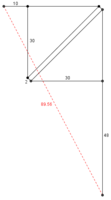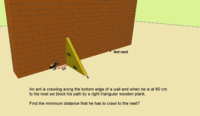You are using an out of date browser. It may not display this or other websites correctly.
You should upgrade or use an alternative browser.
You should upgrade or use an alternative browser.
Minimum distance
- Thread starter Farzin
- Start date
Harry_the_cat
Elite Member
- Joined
- Mar 16, 2016
- Messages
- 3,693
I assume he is not a flying ant?
- Joined
- Apr 12, 2005
- Messages
- 11,339
Consider first the ways the task might be accomplished. Think qualitatively, first. Are there specific ways that are qualitatively different from other ways? As an obvious example, a case that you can discard right away, if the ant backed up and went around the unseen part of the wall, that would be a very different solution from any other solution you might imagine. What other sorts of paths might be taken?
Crawling?I assume he is not a flying ant?
Dr.Peterson
Elite Member
- Joined
- Nov 12, 2017
- Messages
- 16,092
Assuming it's not a carpenter ant, I have a little over 90 cm. Anything less?
Edit: I've got a path 89.56 cm long, and I think that's the best. It's not exactly an obvious path, but it shaved off 0.66 cm.
Edit: I've got a path 89.56 cm long, and I think that's the best. It's not exactly an obvious path, but it shaved off 0.66 cm.
Last edited:
HallsofIvy
Elite Member
- Joined
- Jan 27, 2012
- Messages
- 7,763
The basic problem is to find the shortest distance from the vertex of a right triangle to the hypotenuse. And the shortest distance is along a line from the vertex perpendicular to the hypotenuse.
Dr.Peterson
Elite Member
- Joined
- Nov 12, 2017
- Messages
- 16,092
The basic problem is to find the shortest distance from the vertex of a right triangle to the hypotenuse. And the shortest distance is along a line from the vertex perpendicular to the hypotenuse.
But my path is not a distance to a hypotenuse. It's from one point to another, and is a little more creative ...
My earlier answer, 90.23, also was not to a hypotenuse, and was in turn shorter than a path part of which was perpendicular to a hypotenuse, which totaled 102.43.
But maybe there's an even shorter path that I haven't thought of. I initially thought the problem was too simple to bother actually carrying out, until I tried comparing actual numbers.
Excellent, ≈89.56425 is the shortest path.Assuming it's not a carpenter ant, I have a little over 90 cm. Anything less?
Edit: I've got a path 89.56 cm long, and I think that's the best. It's not exactly an obvious path, but it shaved off 0.66 cm.
Dr.Peterson
Elite Member
- Joined
- Nov 12, 2017
- Messages
- 16,092
Halls, I got the same result, as Dr Peterson, of 109.426 using your method. I can't wait to see Prof Peterson's method.
Here's the idea: Suppose that it goes over the barrier at an angle. The surface over which it moves can be flattened out into this shape:

It goes along the floor to meet the barrier some distance out from the wall, climbs it at an angle, crosses the top, then down the other side, then across the floor to the destination. After flattening it out, the shortest path is the straight line, which is the hypotenuse of a right triangle with legs [MATH]40+\sqrt{2}[/MATH] and [MATH]78+\sqrt{2}[/MATH].

